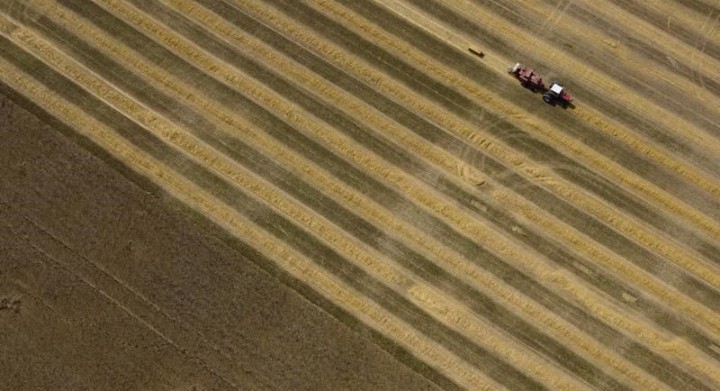The goal of reducing greenhouse gas emissions from fertilizer use by 30 per cent kicked up more dust than a tractor on a grid road when it was first announced by the federal Liberal government last summer.
Now that some of the dust has settled, agriculture and industry groups say that goal can probably be met without reducing yields — although maybe not as quick as Ottawa would like.
“Can we get that additional 30 per cent? I think so,” said Keith Currie, vice-president of the Canadian Federation of Agriculture and a corn producer from Collingwood, Ont.
“But there has to be a combined, collaborative approach by all involved.”
Government figures suggest fertilizer accounts for a growing share of the 10 per cent of Canada’s greenhouse gas emissions that come from agriculture. Agriculture Minister Marie-Claude Bibeau has said reducing those emissions by nearly a third by 2030 is ambitious but must be accomplished.
“We have to have a destination,” she said in an interview last month. “So we got out a target that we aim to.”
Both the government and farmers are placing their trust in an approach known as 4R: right source, right rate, right time and right place.
That means measures such as slow-release fertilizers that give soil time to absorb nutrients. It means understanding the land well enough to know which parcels need more and which need less. It means not applying fertilizer when it’s dry, or using two smaller applications at different times instead of one large one.
It could work, said Karen Proud, president of Fertilizer Canada, but maybe not within the seven growing seasons Ottawa has given farmers.
“It is possible if 100 per cent of the acres in Ontario and Quebec and 60 to 70 per cent of all farm acres in Western Canada adopt the most advanced of our nutrient stewardship practices,” Proud said.
“But we know given where we are today, we are never going to achieve 100 per cent of acres in Ontario and Quebec. And in the short time we have between now and 2030, we are certainly not going to achieve 60 to 70 per cent of all acres in Western Canada.”
Proud’s group recently released a report suggesting a 14 per cent reduction by 2030 is more realistic.
There’s more to fertilizer use than just using fertilizer, said Currie. If farmers are to use latest technologies to get more out of the chemicals, they’ll need the kind of internet service that isn’t available in many rural communities.
“It’s that precision technology that’s going to help us be even better with respect to our cropinputs, which will help with the reduction in emissions,” Currie said. “(We need) to get the government to be really serious about getting 5G and broadband coverage.”
Carbon markets or credits to encourage farmers to adopt lower-emission practices would also help, he said.
“Not that any farmer is going to lift a mortgage off of selling credits, but it’s another tool we can use,” Currie said.
Proud said the government is going to have to spend money to help farmers adapt.
“What we’re asking of government is to sit down with ourselves, with the farm groups, with farmers to talk about what are those barriers to adoption and then how do we work towards reducing that,” she said. “Some of that may be investing in more education at the farm level, so they understand more about the benefits of 4Rs and how that actually helps increase productivity.”
Bibeau said the government has committed to getting 5G internet to 98 per cent of Canadians by 2026, if the provinces co-operate. She also said she’s listening — consultations with farm groups began in March and recently concluded.
“I think we have demonstrated through the years how open we are and how many consultations we can do,” she said.
Bibeau said Ottawa has increased the $3-billion Canadian Agricultural Partnership Agreement by $500 million.
There are other ways to decrease fertilizer emissions other than just using them more efficiently, said Ralph Martin, a retired agriculture professor from the University of Guelph. Most emissions come as fertilizer is made from fossil fuels, he said, so why not look for nutrients from another source?
“What we should really be looking at is human sewage.”
Eliminating waste in crop production would also reduce pressure for fertilizer-driven high yields, Martin said.
He said fertilizer use and farm prosperity aren’t necessarily the same thing.
Fertilizers can create higher yields, but they also increase expenses. Many farmers might be happy to use less fertilizer, but they need incentives to make the change.
“Farmers have a lot invested, a lot of dollars on the line,” Martin said. “If we had incentives, I think farmers would respond.”
Bibeau said she’s optimistic the goal will be met. Fertilizer Canada’s estimate of a 14 per cent reduction is good news, she said.
“This is already great. There will be new practices, new inputs, new technologies that will develop in the coming months and years.”
Farmers are on board, said Currie. They just need realistic plans.
“We never have not been willing to do our part. But the government’s got to do a better job communicating where they want to go and how.”
This report by The Canadian Press was first published Nov. 3, 2022.
— Follow Bob Weber on Twitter at @row1960
Bob Weber, The Canadian Press
Related


































